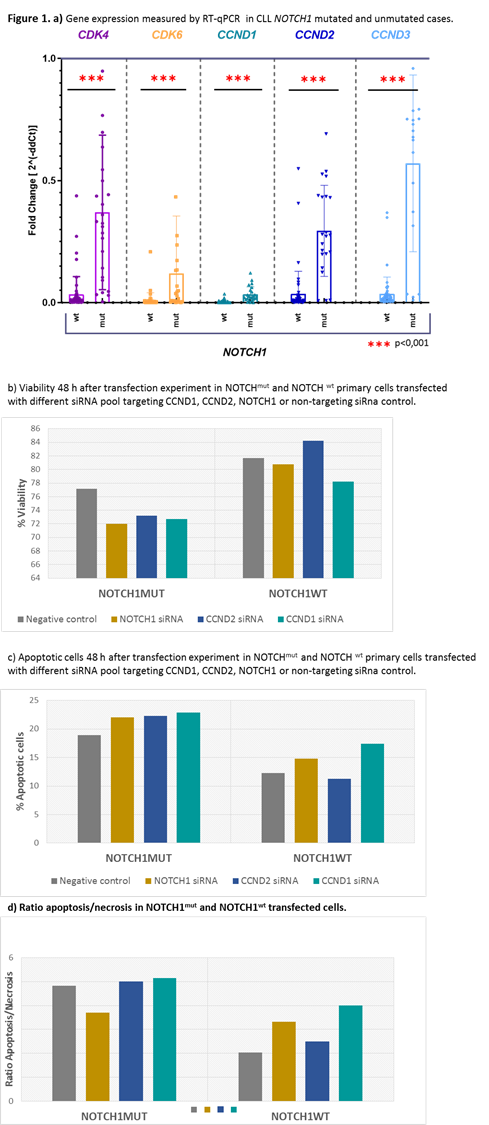Background and Aim: Chronic lymphocytic leukemia (CLL) is an incurable neoplasm with considerable clinical heterogeneity that is underpinned by distinct genetic changes. This poses a great challenge to the development of effective treatment, as responses to novel therapies may vary depending upon the biological subtype of disease. NOTCH1 has emerged as the most commonly mutated gene in CLL at diagnosis, its frequency rises with progression, and the variant c.7541_7542delCT accounts for approximately 80% of cases. NOTCH1-mutated (NOTCH1mut) CLL subset represents a subtype that responds poorly to anti-CD20 drugs, has worse outcomes, and a proliferative profile. We aimed, among the proliferative signals, to study the D-type cyclins that govern cell cycle entry in a NOTCH1mut subset which lacks an accurate targeted therapy.
Methods: We performed targeted sequencing on 289 CLL cases with a TruSeq Custom Amplicon panel from Illumina, containing 13 genes recurrently mutated in CLL. Paired-end sequencing reached a mean depth of 938 reads/base. Out of 30 NOTCH1mut patients, RNA from the CD19+ fraction was available in 25 cases. Cyclins D1, D2, D3 and cyclin dependent kinases CDK4 and CDK6 expression was measured by RT-qPCR in 25 NOTCH1mut and 57 NOTCH1wild type (NOTCH1wt). CD19+ B-CLL cells from 7 NOTCH wt and 2 NOTCH1mut patients were cultured in Expansion Human Media supplemented with CD40L, IL-4 antibiotics and inactivated BFS. On day ten 2,5x105 B cells were added to a combination of ON-TARGETplus SMART pool siRNA NOTCH1, pool siRNA CCND1, SMART pool siRNA CCND2, or ON-TARGETplus siCONTROL as negative control. Electroporation was performed with Neon Transfection System in 10 ul tips using settings of 1400 volts, 10ms width, and 3 pulses. Transfected cells were double stained with Annexin V-FITC conjugate and PI in isotonic solution, and then analyzed by FC. Viable cells were defined as double negative cells.
Results: A total of 82 CLL patients, 25 NOTCH1mut and 57 NOTCH1wt were included in the RT-qPCR study. Figure 1a shows fold change expression and p value comparing NOTCH1mutvs.NOTCH1wt of CDK4 (FC= 11,1; p<0,001), CDK6 (FC= 11,2; p<0,001), CCND1 (FC= 8,9; p<0,001), CCND2 (FC= 8,4; p<0,001), and CCND3 (FC= 15; p<0,001). As cyclin D2 and CDK4 are located both on chromosome 12, we next checked whether that overexpression was due to copy number gains. However, we found no significant differences in the expression of Cyclin D2 in trisomy 12 NOTCH1mut cases (n=3) vs. non trisomy 12 NOTCH1mut cases (n=22) (0,28 vs. 0,37; p= 0,8) while CDK4 expression was higher in trisomy 12 NOTCH1mut vs. non trisomy 12 NOTCH1mut cases with a trend to reach statistical significant (0,74 vs. 0,29; p= 0,06). Cell culture from 7 CLL patients was stable until optimal day of culture and confluency for transfection and apoptosis assay. Viability was studied by the trypan blue dye exclusion test. Patients with NOTCH1mut kept a higher cell count and viability than NOTCH1 wt (70% cell survival in NOTCH1mut vs. 45% in NOTCH1wt on day +8).
Next we transfected cultured primary cells from two c.7541_7542delCTNOTCH1mut and 5 NOTCH1wt patients. Figure 1b shows the cell viability assay after 48 h of the transfection, highlighting a marked reduction in viable cells in NOTCH1mut cases in each silencing experiment, (siRNA_Control: 77% NOTCH1sirna: 71 %, CCND2siRNA: 73% and CCND1: 72%) which was not paralleled in NOTCH1wt cases (siRNA_Control: 81% NOTCH1sirna: 80 %, CCND2siRNA: 84% and CCND1: 78 %). Figure 1C shows how the apoptosis index increased in every silencing experiment compared with NOTCH1mut siRNA pool control. However, for therapeutic purposes the accurate approach should increase apoptosis, leading the cells to a controlled death, and reduce necrosis, which is responsible of inflammation and collateral damage. The optimal apoptosis/necrosis ratio in our experiments, it is shown by the silencing of CCDN2 in NOTCH1mut (ratio A/N=5,15) where percentage of necrotic cells was markedly reduced (fig.1d).
Conclusions: We found a marked upregulation of cyclins governing the transition from G1 to S phase of the cell cycle in patients with CLL and NOTCH1 mutation compared with those wild type cases for this lesion. In addition, silencing of cyclin D2 in the NOTCH1mut CLL subset was able to reach a similar degree of apoptosis than silencing NOTCH1, with a more favourable reduction of necrosis, emerging as a suitable candidate for a therapeutic target.
Jerez:Novartis: Honoraria; Celgene: Consultancy, Honoraria, Membership on an entity's Board of Directors or advisory committees.
Author notes
Asterisk with author names denotes non-ASH members.


This feature is available to Subscribers Only
Sign In or Create an Account Close Modal